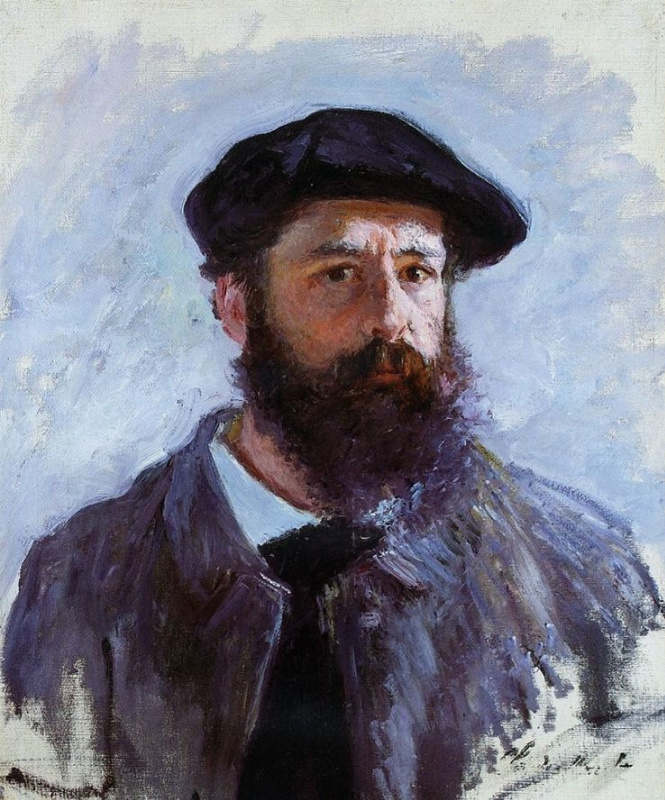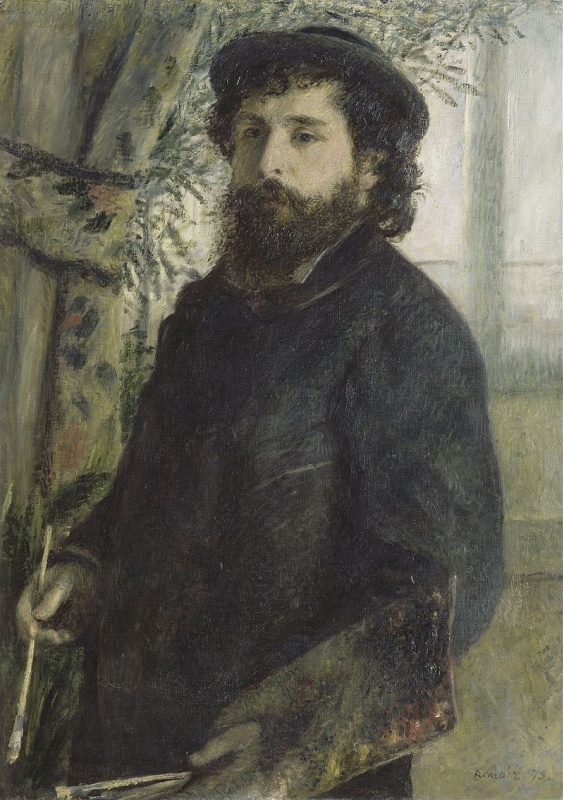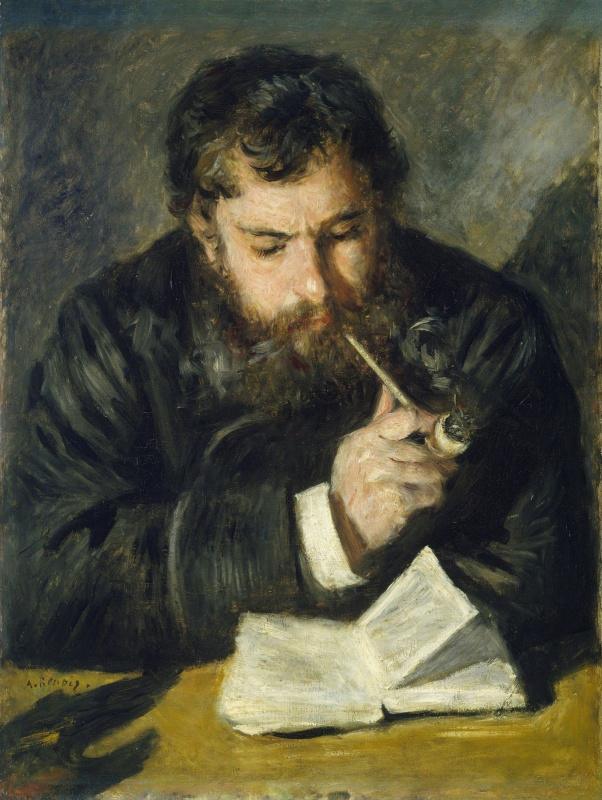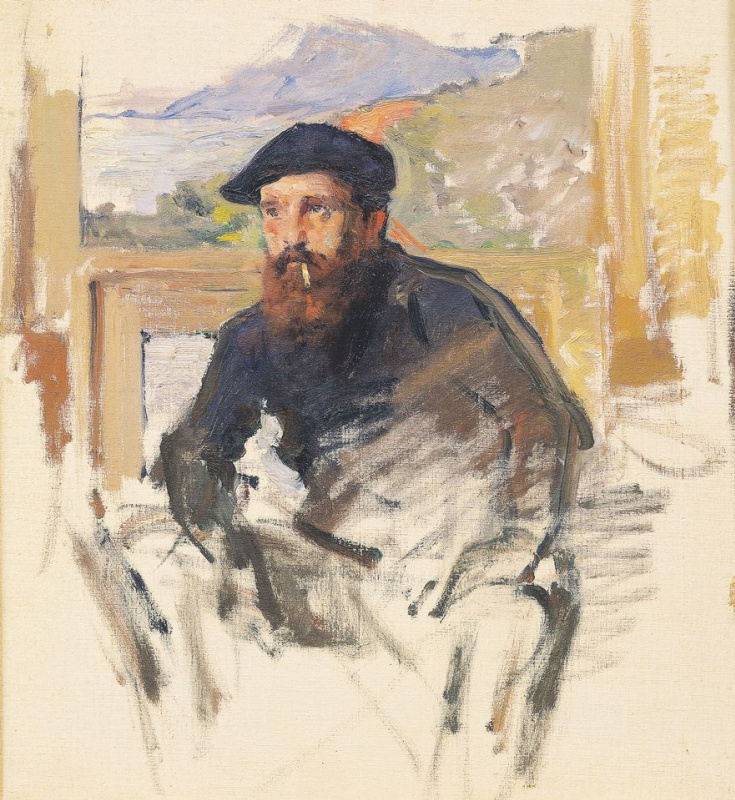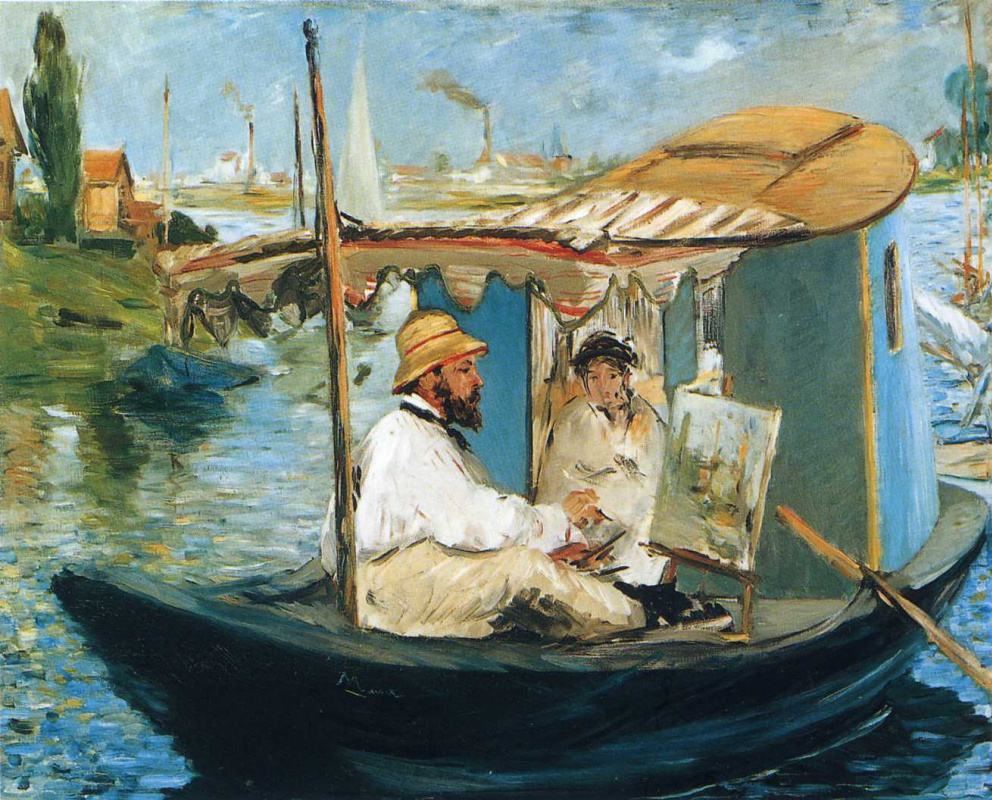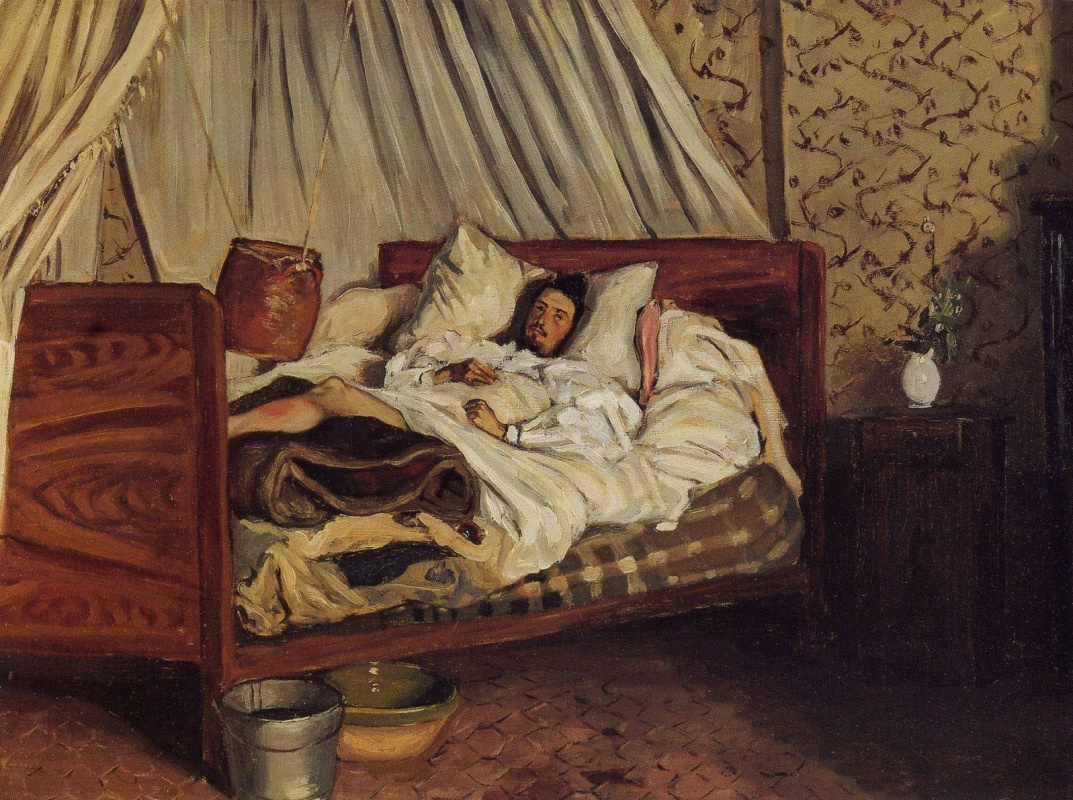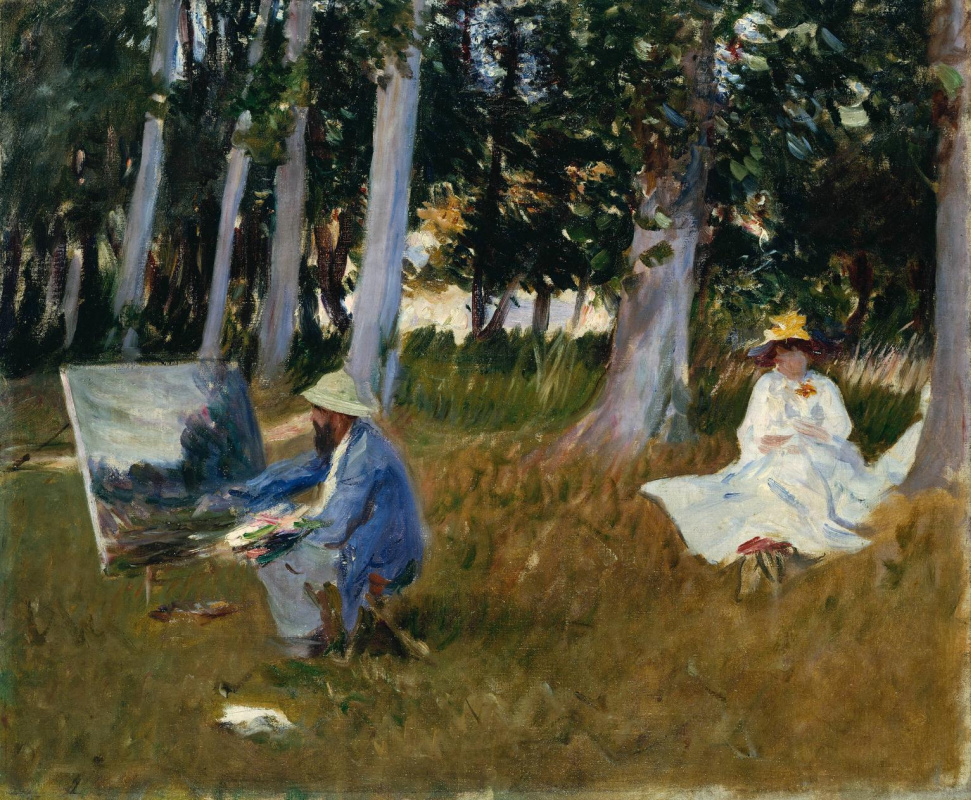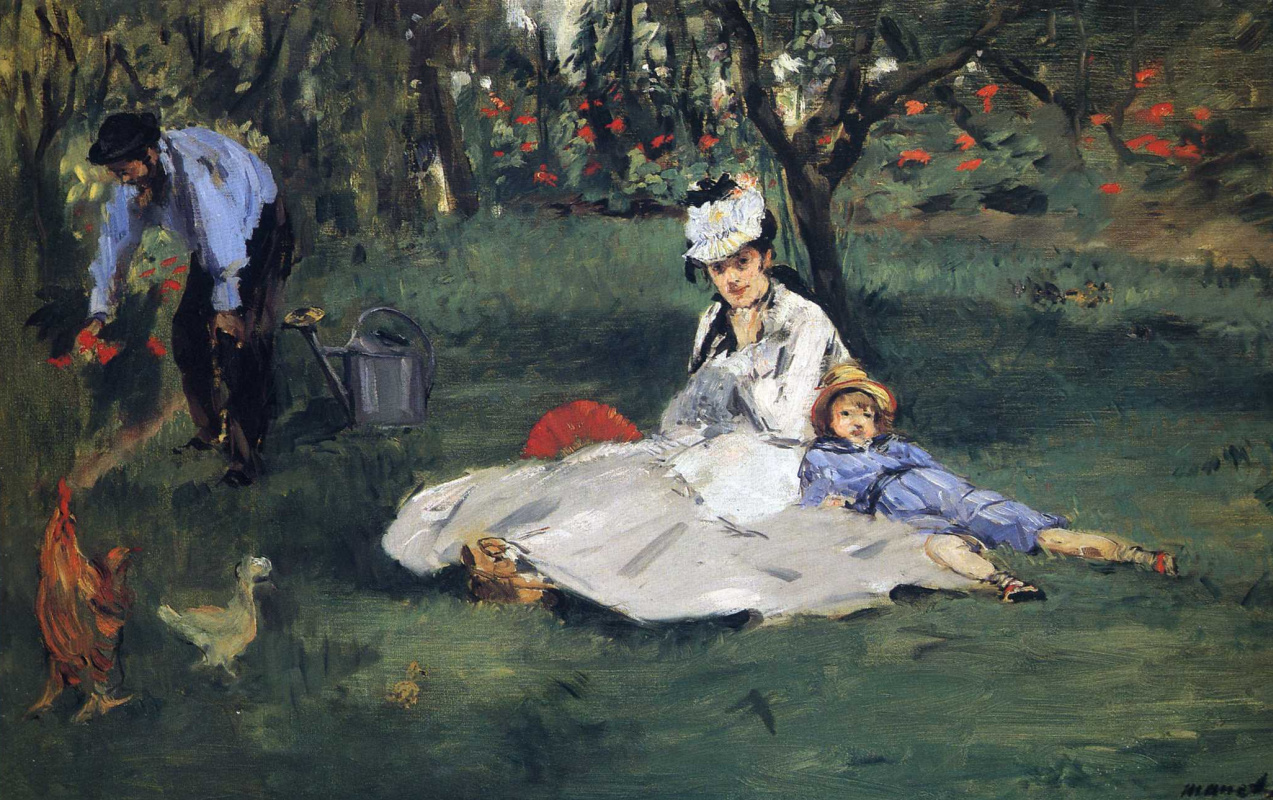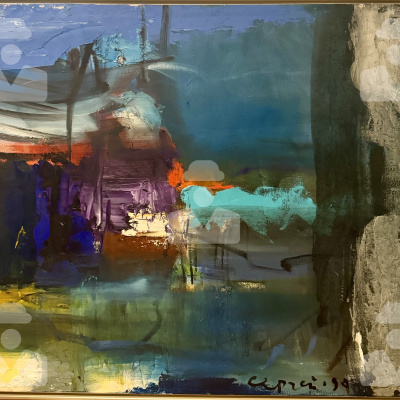We can hardly find Claude Monet in his photos, pictures and self portraits dressed in a blouse, something like a shapeless robe which served for an artist as work clothes and with a duster for cleaning of brushes. Monet’s friends painted his portraits more often than their associates, for instance, Monet in the open air, Monet and his family, Monet reading a book, and even Monet with a broken leg and the weight tied to it. A dandy, heedless fashionmonger and bohemian artist was depicted in those paintings. He worked on board of his boat — studio dressed in a white shirt (it seemed so starched that it looked crisp and fresh), wearing a tie; he was painting a picture in his large studio in Giverny dressed in a suit. Auguste Renoir told about him with a smile that he had been born a nobleman.
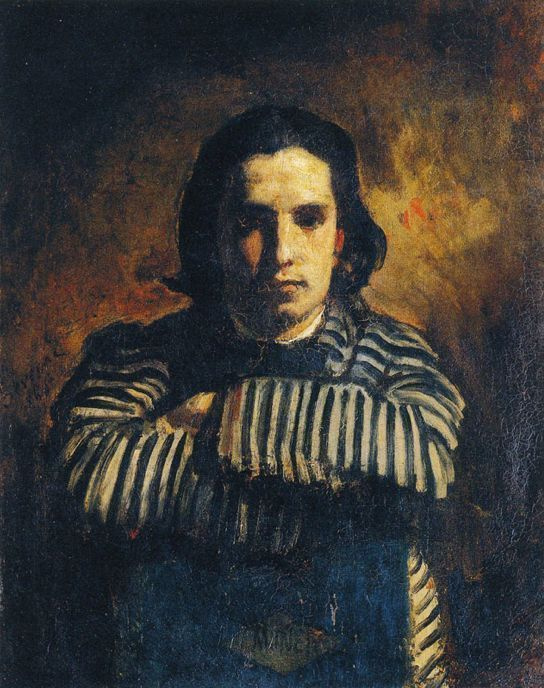
Monet and Mrs. Monet in a boat
1874, 82.5×100.5 cm
We have to mention that Monet was not born a nobleman. Monet’s farther had a grocery shop in Le Havre, a port city in the Normandy region. And had it not been a talent for painting revealed in a small wanderer, chronic absentee and a D-student, he would have sold flour and spices for the residents of La Havre.
In his caricatures 17 year old Monet along with particular people, his neighbors, teachers and friends also painted funny pictures of fashion-mongers. All those dandies' minds were occupied only with handkerchiefs and stylish boots; he would have never become like them.
When Monet visited the Gleyre's studio in Paris for the first time, where Renoir and Bazille studied painting that time, he produced a great impression on the students. He squeamishly refused to take a stool offered to him and called it the stool for doing milking and in some days he would sit on the Gleter’s place convincing his teacher, that he needed that place to scrutinize the skin of the model. Everybody was shocked with his behavior. The student gave him a nickname Dandy and a few young girls studying there vied in paying him every attention. Monet spluttered out to one of the young ladies, who demonstrated a defiant attitude that his lovers were only duchesses or maids. The golden mean made him vomit. The perfect choice could be a maid of a duchess.
Claude Monet had never been neither too sportive nor subtle, he was stubby and rather short, he stood one meter 65 centimeters, when he was 35 he had a spade beard and he became fatter. He always stayed clear and enchanted everybody in some inexplicable way.
Renoir’s son Jean recollected his father’s stories about his young years, when he and his friends artists were poor and sometimes did not have money to pay for their food. According to Jean, his father shared his flat with Monet. Claude had an amazing talent of persuading vendors to commission their portraits from the artists at the price of fifty francs each, which allowed them to have hardly enough money to keep body and soul together. Sometimes they did not have any order. At the same time Monet was dressed in shirts with lace and ordered his suits from the best Parisian tailor. He had never paid for his clothes and reacted on the bills with a dismissive haughtiness of Dom Juan receiving Monsieur Dimanche. The answer was that if the tailor insisted he would never make any order again. The tailor had never insisted adoring so arrogant behavior.
Renoir’s son Jean recollected his father’s stories about his young years, when he and his friends artists were poor and sometimes did not have money to pay for their food. According to Jean, his father shared his flat with Monet. Claude had an amazing talent of persuading vendors to commission their portraits from the artists at the price of fifty francs each, which allowed them to have hardly enough money to keep body and soul together. Sometimes they did not have any order. At the same time Monet was dressed in shirts with lace and ordered his suits from the best Parisian tailor. He had never paid for his clothes and reacted on the bills with a dismissive haughtiness of Dom Juan receiving Monsieur Dimanche. The answer was that if the tailor insisted he would never make any order again. The tailor had never insisted adoring so arrogant behavior.
Modern art experts adore him as much as the above tailor. Monet was born a marketer and was able to make an impression he needed. He was aware of that the public requires myths and created them with the enthusiasm. After the first exhibition of the modern artists about the modern life, who was later called impressionists, and its failure, Paul Cézanne went to his parents to Aix, Renoir stopped dining at the neighboring creamery because the sum of his debt was too high and Claude put on his best suit and a shirt with lacy cuffs, took his walking stick topped with gold and politely and arrogantly at the same time he introduced himself to the director of the railway station as Monet, an artist, and informed the director of the Saint-Lazare railway station on his intention of painting his station. He was provided with anything he wanted. Trains were stopped when he required, the platform was cleaned from the crowd, fireboxes were packed with coal to produce as much smoke as Monet demanded. He became a tyrant of the station, painted surrounded with adoration and at last left the station with a half of a dozen of paintings; all the personnel headed by the director were bowing saying him good bye. Renoir was laughing when he recollected that event.
In the photo towards left: Claude Monet in Giverny, 1889. The photo was taken by Theodore Robinson, one of the first American pilgrims who traveled a lot and visited Monet in Giverny getting knowledge and learning his oeuvre, he founded there a colony of the American pilgrims who admired the artist’s artworks. Due to Monet and his overseas admirers (1, 2, 3, 4) the hotel business in Giverny, a small village that time, became very profitable.
In the photo towards right: the illustration from the art book by Rebekah Wrye Owens, a painter. American Fashion bloggers like this picture depicting Monet; they claim that Monet was the first hipster, we could say, it is a full hundred per cent penetration into the style.
In the photo towards right: the illustration from the art book by Rebekah Wrye Owens, a painter. American Fashion bloggers like this picture depicting Monet; they claim that Monet was the first hipster, we could say, it is a full hundred per cent penetration into the style.
Even during persistent campaign against impressionists and overall mockery, the impressionist artists were well known. Only Cézanne, Pissarro and Sisley due to different reasons were not engaged in the social life. The others made useful social contacts and solicited orders during parties with celebs and pink teas. Sharp fellows and freethinkers, writers, travelers, journalists and publishers came to those parties held at the most popular salons. It was dull for them to support the classical art and they advocated the repudiated artists with a revolutionary enthusiasm. Just at the same party at the Ernest Hoschedé's Monet fell in love with the wife of the store magnate, art collector and freethinker Alice Hoschedé and spent with her and her six children a half of his life.
The society of that time used to be fascinated new trend setters, so-called society lions but not dandies spending thousands of francs for their perfect way they looked. Vera Milchina, a literary historian, French translator and the author of the book the "Paris in 1814 — 1848" described in her book that special Parisian class of intellectual fashionmongers. According to her, lions differed from dandies. They were the persons exciting the overall curiosity with their deeds but not their appearance. In the 1830 — 1840s the lions were called those people who would be called stars nowadays. At the same time, dandies dreamed to join the rows of the lions and attract the attention of the public to their own personalities. According to Delphine de Girardin, a dandy wanted to be looked at and a lion was a person who people wanted to look at.
Monet was born in 1840, however, even some dozens of years later the lions were still whispered or loudly spoken about; the lions became trendsetters and moreover, they created the image with their own way of life, which was inaccessible to a lot of dandies. Monet was dressed in shirts with embroidered and lacy sleeve cuffs, which had been out of fashion by that time, though, a lot of his friends and acquaintances mentioned those notorious, old fashion, impressive and gorges sleeve cuffs in their memories.
The society of that time used to be fascinated new trend setters, so-called society lions but not dandies spending thousands of francs for their perfect way they looked. Vera Milchina, a literary historian, French translator and the author of the book the "Paris in 1814 — 1848" described in her book that special Parisian class of intellectual fashionmongers. According to her, lions differed from dandies. They were the persons exciting the overall curiosity with their deeds but not their appearance. In the 1830 — 1840s the lions were called those people who would be called stars nowadays. At the same time, dandies dreamed to join the rows of the lions and attract the attention of the public to their own personalities. According to Delphine de Girardin, a dandy wanted to be looked at and a lion was a person who people wanted to look at.
Monet was born in 1840, however, even some dozens of years later the lions were still whispered or loudly spoken about; the lions became trendsetters and moreover, they created the image with their own way of life, which was inaccessible to a lot of dandies. Monet was dressed in shirts with embroidered and lacy sleeve cuffs, which had been out of fashion by that time, though, a lot of his friends and acquaintances mentioned those notorious, old fashion, impressive and gorges sleeve cuffs in their memories.

Claude Monet in Giverny, 1905. In the photo below Claude Monet in 1887 and 1890
In due time after Monet had earned enough money, recognition and opportunity to live calmly away from the capital city, he in a mysterious way switched to another level of myth creation; the imposing heart-breaker turned into a bearded silent grumbler of genius; journalists stood in line to do the interview from the first hands and photographers dreamed to take photo of him for history. Suddenly waked up art critics and newsmakers did interviews with him to inscribe on memory the history of Impressionism for peers and descendants with the secrets and details of the past.
A dandy, lion and a rich man in the past Monet was walking along the provincial Giverny dressed in a jacket with its sleeves tied on the back and creating future; he became the most popular French gardener and produced large pictures (1, 2, 3, 4), which would need some dozens of the years from journalists, art-critics and public to be understood and recognized.
The central illustration: Gilbert Alexandre de Severac, the Portrait of Claude Monet, 1865
The author: Anna Sidelnikova
A dandy, lion and a rich man in the past Monet was walking along the provincial Giverny dressed in a jacket with its sleeves tied on the back and creating future; he became the most popular French gardener and produced large pictures (1, 2, 3, 4), which would need some dozens of the years from journalists, art-critics and public to be understood and recognized.
The central illustration: Gilbert Alexandre de Severac, the Portrait of Claude Monet, 1865
The author: Anna Sidelnikova






